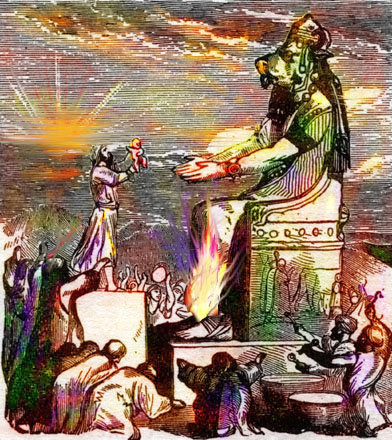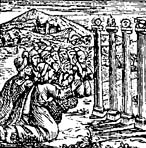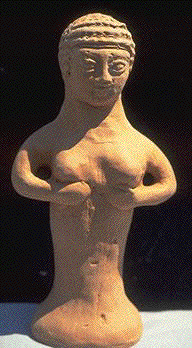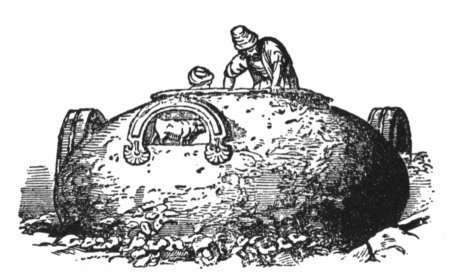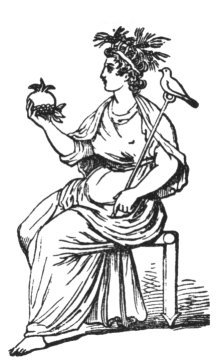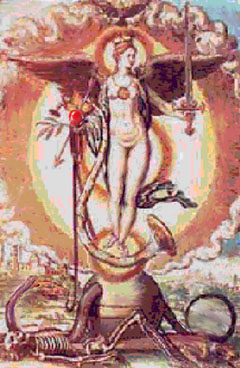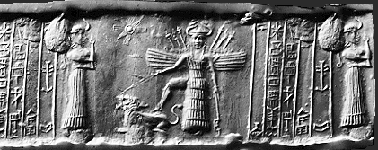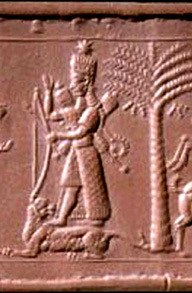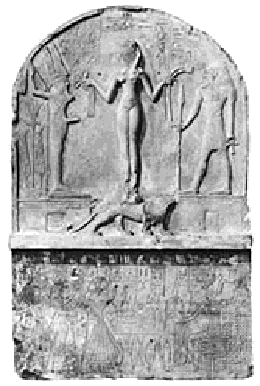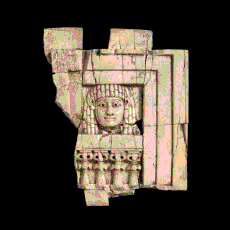Easter -The Two Babylons Alexander Hislop "When Solomon grew old his wives swayed his heart to other gods; and his heart was not wholly with Yahweh his God as his father David's had been. Solomon became a follower of Astarte, the goddess of the Sidonians." - 1 Kings 11: 4-5And Isaiah prophesied when "women and children shall rule over you." Now.
History shows that pagan fertility rites are often slyly disguised as SECOND INCARNATIONS. For instance, Dr. Rubel Shelly associates the S.U.N god with the S.O.N god. Dr. Shelly uses words quite identical to the Catholic Encyclopedia which admits to having "baptized" all kinds of pagan festivals and instrumental music to make their own rituals more "exhilarating." It was apparently left to a Disciples member in about 1878 to try to find Biblical justification for it. See lighting of Advent Candles.
In addition, Rubel Shelly and John York "baptized" the exodus story to make it a "pattern for Christian worship and community." However, the "because of transgression" for the law was a return to musical idolatry within God's "testing period" of 40 days. God then turned them over to "worship the starry host" of which the S.U.N and Saturn were principle "gods." To worship the S.U.N under Molech you had to burn babies in the red hot arms of an idol while the musical instruments made a great crashing noise and the priests "interpreted" the cries and sounds as a "message" from the S.U.N. god.
Therefore, if the worship of the "starry hosts" is our new pattern then why not make the S.O.N. god into a S.U.N. god. Just baptize him.
Along with this ancient patternism goes the restoration of the official celebration of Christmas and Easter.
See also on Easter Hislop 5.5
See the connection betwen Inanna (Ishtar, Easter) and the egg.
See the Orphic Theogonomy and the Cosmic Egg
Worship of Astarte or Ishtar-Tammuz at the Jerusalem temple.
Hislop shows the connection between Tammuz worship and Sun worship as Easter is the worship of the sun. Hislop 7.1
Chapter III Section II Easter
Then look at Easter. What means the term Easter itself? It is not a Christian name.
........... It bears its Chaldean origin on its very forehead.Easter is nothing else than Astarte, one of the titles of Beltis, the queen of heaven, whose name, as pronounced by the people Nineveh, was evidently identical with that now in common use in this country. That name, as found by Layard on the Assyrian monuments, is Ishtar.
The worship of Bel and Astarte was very early introduced into Britain, along with the Druids, "the priests of the groves." Some have imagined that the Druidical worship was first introduced by the Phoenicians, who, centuries before the Christian era, traded to the tin-mines of Cornwall. But the unequivocal traces of that worship are found in regions of the British islands where the Phoenicians never penetrated, and it has everywhere left indelible marks of the strong hold which it must have had on the early British mind.
From Bel, the 1st of May is still called Beltane in the Almanac; and we have customs still lingering at this day among us,
........... which prove how exactly the worship of Bel or Moloch (for both titles belonged to the same god)had been observed even in the northern parts of this island. "The late Lady Baird, of Fern Tower, in Perthshire," says a writer in "Notes and Queries," thoroughly versed in British antiquities, "told me, that every year, at Beltane (or the 1st of May), a number of men and women assemble at an ancient Druidical circle of stones on her property near Crieff. They light a fire in the centre, each person puts a bit of oat-cake in a shepherd's bonnet; they all sit down, and draw blindfold a piece from the bonnet.
One piece has been previously blackened, and whoever gets that piece has to jump through the fire in the centre of the circle, and pay a forfeit.
This is, in fact, a part of the ancient worship of Baal, and the person on whom the lot fell was previously burnt as a sacrifice. Now, the passing through the fire represents that, and the payment of the forfeit redeems the victim."
the religious solemnities of April, as now practised, are called by the name of Easter--that month, among our Pagan ancestors, having been called Easter-monath.
The festival, of which we read in Church history, under the name of Easter, in the third or fourth centuries, was quite a different festival from that now observed in the Romish Church, and at that time was not known by any such name as Easter.
It was called Pasch, or the Passover, and though not of Apostolic institution, * was very early observed by many professing Christians, in commemoration of the death and resurrection of Christ.
* Socrates, the ancient ecclesiastical historian, after a lengthened account of the different ways in which Easter was observed in different countries in his time--i.e., the fifth century--sums up in these words: "Thus much already laid down may seem a sufficient treatise to prove that the celebration of the feast of Easter began everywhere more of custom than by any commandment either of Christ or any Apostle." (Hist. Ecclesiast.) Every one knows that the name "Easter," used in our translation of Acts 12:4, refers not to any Christian festival, but to the Jewish Passover. This is one of the few places in our version where the translators show an undue bias.
That festival agreed originally with the time of the Jewish Passover, when Christ was crucified, a period which, in the days of Tertullian, at the end of the second century, was believed to have been the 23rd of March. That festival was not idolatrous, and it was preceded by no Lent. "It ought to be known," said
Cassianus, the monk of Marseilles, writing in the fifth century, and contrasting the primitive Church with the Church in his day,
"that the observance of the forty days had no existence, so long as the perfection of that primitive Church remained inviolate."Whence, then, came this observance? The forty days' abstinence of Lent was directly borrowed from the worshippers of the Babylonian goddess.
Such a Lent of forty days, "in the spring of the year," is still observed by the Yezidis or Pagan Devil-worshippers of Koordistan, who have inherited it from their early masters, the Babylonians.
See also Hislop on Wax Candles and the confession that Catholics borrowed from Pagans.
Such a Lent of forty days was held in spring by the Pagan Mexicans, for thus we read in Humboldt, where he gives account of Mexican observances: "Three days after the vernal equinox...
........... began a solemn fast of forty days in honour of the sun."Such a Lent of forty days was observed in Egypt, as may be seen on consulting Wilkinson's Egyptians. This Egyptian Lent of forty days, we are informed by Landseer, in his Sabean Researches, was held expressly in commemoration of Adonis or Osiris, the great mediatorial god.
At the same time, the rape of Proserpine seems to have been commemorated, and in a similar manner; for Julius Firmicus informs us that, for "forty nights" the "wailing for Proserpine" continued; and from Arnobius we learn that the fast which the Pagans observed, called "Castus" or the "sacred" fast, was, by the Christians in his time,
believed to have been primarily in imitation of the long fast of Ceres, when for many days she determinedly refused to eat on account of her "excess of sorrow," that is, on account of the loss of her daughter Proserpine, when carried away by Pluto, the god of hell.
As the stories of Bacchus, or Adonis and Proserpine, though originally distinct, were made to join on and fit in to one another, so that Bacchus was called Liber, and his wife Ariadne, Libera (which was one of the names of Proserpine), it is highly probable that the forty days' fast of Lent was made in later times to have reference to both.
Among the Pagans this Lent seems to have been an indispensable preliminary to the great annual festival in commemoration of the death and resurrection of Tammuz, which was celebrated by alternate weeping and rejoicing, and which, in many countries, was considerably later than the Christian festival, being observed in Palestine and Assyria in June, therefore called the "month of Tammuz"; in Egypt, about the middle of May, and in Britain, some time in April.
Music, Ishtar or Astarte and Tammuz
To conciliate the Pagans to nominal Christianity, Rome, pursuing its usual policy,
took measures to get the Christian and Pagan festivals amalgamated, and, by a complicated but skilful adjustment of the calendar, it was found no difficult matter, in general,
........... to get Paganism and Christianity--now far sunk in idolatry--in this as in so many other things, to shake hands.This is identical to the urge for a Seeker-Center to suck in numbers and hopefully more paying members but fewer and fewer "insiders" until you have a Catholic form of religion. It is complete with the worship of the Spirit as a separated "person" and then she has a second incarnation as ZOE. Lucifer was bisexual and therefore it is hard to tell who is who. However, an all of the ancient records it is a Lucifer type person who teaches mankind how to form mixed-sex choirs, drink wine and form instrumenta bands to seduce the holy people off God's "mountain" or away from the authority of the Living Word. In the Sophia-ZOE story little ignorang "jehovah" is taken in hand by Zoe as beast and "female instructing principle." The first thing she forces "jehovah" to do was to form a musical worship ministry. Guess who was worshiped: why ZOE and Zophia or now, Mary the mother of the gods. However, it was the Apollo, Apollyon or Abbadon creature whose Seeker-Center has been recorded in history. He used musical teachers, effeminate priests, used music to seduce, had a theater with columns like those above, had a swimming pool, a gymnasium and everything required to strip people of the Truth and of their money.
The instrument in accomplishing this amalgamation was the abbot Dionysius the Little, to whom also we owe it, as modern chronologers have demonstrated, that the date of the Christian era, or of the birth of Christ Himself, was moved FOUR YEARS from the true time. Whether this was done through ignorance or design may be matter of question; but there seems to be no doubt of the fact, that the birth of the Lord Jesus was made full four years later than the truth. This change of the calendar in regard to Easter was attended with momentous consequences. It brought into the Church the grossest corruption and the rankest superstition in connection with the abstinence of Lent.
Let any one only read the atrocities that were commemorated during the "sacred fast" or Pagan Lent, as described by Arnobius and Clemens Alexandrinus, and surely he must blush for the Christianity of those who, with the full knowledge of all these abominations,
"went down to Egypt for help"
to stir up the languid devotion of the degenerate Church,
and who could find no more excellent way to "revive" it,
than by borrowing from so polluted a source;
the absurdities and abominations connected with which the early Christian writers had held up to scorn.That Christians should ever think of introducing the Pagan abstinence of Lent was a sign of evil; it showed how low they had sunk, and it was also a cause of evil; it inevitably led to deeper degradation.
Originally, even in Rome, Lent, with the preceding revelries of the Carnival, was entirely unknown; and even when fasting before the Christian Pasch was held to be necessary,
it was by slow steps that, in this respect, it came to conform with the ritual of Paganism.
In the Apollo Seeker Center he actually "Navigated the Winds" to kidnap priests for the numerous ministeries in his seeker center. Music was connected to this navigating.
What may have been the period of fasting in the Roman Church before sitting of the Nicene Council does not very clearly appear, but for a considerable period after that Council, we have distinct evidence that it did not exceed three weeks. *
* GIESELER, speaking of the Eastern Church in the second century, in regard to Paschal observances, says: "In it [the Paschal festival in commemoration of the death of Christ] they [the Eastern Christians] eat unleavened bread, probably like the Jews, eight days throughout...There is no trace of a yearly festival of a resurrection among them, for this was kept every Sunday" (Catholic Church). In regard to the Western Church, at a somewhat later period--the age of Constantine--fifteen days seems to have been observed to religious exercises in connection with the Christian Paschal feast, as appears from the following extracts from Bingham, kindly furnished to me by a friend, although the period of fasting is not stated. Bingham (Origin) says: "The solemnities of Pasch [are] the week before and the week after Easter Sunday--one week of the Cross, the other of the resurrection. The ancients speak of the Passion and Resurrection Pasch as a fifteen days' solemnity. Fifteen days was enforced by law by the Empire, and commanded to the universal Church...Scaliger mentions a law of Constantine, ordering two weeks for Easter, and a vacation of all legal processes."
The words of Socrates, writing on this very subject, about AD 450, are these: "Those who inhabit the princely city of Rome fast together before Easter three weeks, excepting the Saturday and Lord's-day."
But at last, when the worship of Astarte was rising into the ascendant, steps were taken to get the whole Chaldean Lent of six weeks, or forty days, made imperative on all within the Roman empire of the West.
The way was prepared for this by a Council held at Aurelia in the time of Hormisdas, Bishop of Rome, about the year 519, which decreed that Lent should be solemnly kept before Easter. It was with the view, no doubt, of carrying out this decree that the calendar was, a few days after, readjusted by Dionysius. This decree could not be carried out all at once.
About the end of the sixth century, the first decisive attempt was made to enforce the observance of the new calendar. It was in Britain that the first attempt was made in this way; and here the attempt met with vigorous resistance. The difference, in point of time, betwixt the Christian Pasch, as observed in Britain by the native Christians, and the Pagan Easter enforced by Rome, at the time of its enforcement, was a whole month; *
and it was only by violence and bloodshed, at last, that the Festival of the Anglo-Saxon or Chaldean goddess came to supersede that which had been held in honour of Christ.
* CUMMIANUS, quoted by Archbishop USSHER, Sylloge Those who have been brought up in the observance of Christmas and Easter, and who yet abhor from their hearts all Papal and Pagan idolatry alike, may perhaps feel as if there were something "untoward" in the revelations given above in regard to the origin of these festivals. But a moment's reflection will suffice entirely to banish such a feeling. They will see, that if the account I have given be true, it is of no use to ignore it.
A few of the facts stated in these pages are already known to Infidel and Socinian writers of no mean mark, both in this country and on the Continent, and these are using them in such a way as to undermine the faith of the young and uninformed in regard to the very vitals of the Christian faith. Surely, then, it must be of the last consequence, that the truth should be set forth in its own native light, even though it may somewhat run counter to preconceived opinions, especially when that truth, justly considered, tends so much at once to strengthen the rising youth against the seductions of Popery, and to confirm them in the faith once delivered to the Saints. If a heathen could say, "Socrates I love, and Plato I love, but I love truth more," surely a truly Christian mind will not display less magnanimity.
Is there not much, even in the aspect of the times, that ought to prompt the earnest inquiry, if the occasion has not arisen, when efforts, and strenuous efforts, should be made to purge out of the National Establishment in the south those observances, and everything else that has flowed in upon it from Babylon's golden cup? There are men of noble minds in the Church of Cranmer, Latimer, and Ridley, who love our Lord Jesus Christ in sincerity, who have felt the power of His blood, and known the comfort of His Spirit. Let them, in their closets, and on their knees, ask the question, at their God and at their own consciences, if they ought not to bestir themselves in right earnest, and labour with all their might till such a consummation be effected.
Then, indeed, would England's Church be the grand bulwark of the Reformation--then would her sons speak with her enemies in the gate--then would she appear in the face of all Christendom, "clear as the sun, fair as the moon, and terrible as an army with banners." If, however, nothing effectual shall be done to stay the plague that is spreading in her, the result must be disastrous, not only to herself, but to the whole empire.
Such is the history of Easter. The popular observances that still attend the period of its celebration amply confirm the testimony of history as to its Babylonian character. The hot cross buns of Good Friday, and the dyed eggs of Pasch or Easter Sunday, figured in the Chaldean rites just as they do now.
The "buns," known too by that identical name, were used in the worship of the queen of heaven, the goddess Easter, as early as the days of Cecrops, the founder of Athens--that is, 1500 years before the Christian era. "One species of sacred bread," says Bryant, "which used to be offered to the gods, was of great antiquity, and called Boun." Diogenes Laertius, speaking of this offering being made by Empedocles, describes the chief ingredients of which it was composed, saying, "He offered one of the sacred cakes called Boun, which was made of fine flour and honey."
The prophet Jeremiah takes notice of this kind of offering when he says, "The children gather wood, the fathers kindle the fire, and the women knead their dough, to make cakes to the queen of heaven." *
* Jeremiah 7:18. It is from the very word here used by the prophet that the word "bun" seems to be derived. The Hebrew word, with the points, was pronounced Khavan, which in Greek became sometimes Kapan-os (PHOTIUS, Lexicon Syttoge); and, at other times, Khabon (NEANDER, in KITTO'S Biblical Cyclopoedia). The first shows how Khvan, pronounced as one syllable, would pass into the Latin panis, "bread," and the second how, in like manner, Khvon would become Bon or Bun. It is not to be overlooked that our common English word Loa has passed through a similar process of formation. In Anglo-Saxon it was Hlaf.
Ishtar: the Queen of Heaven (Eve, Sophia, ZOE, Mary)
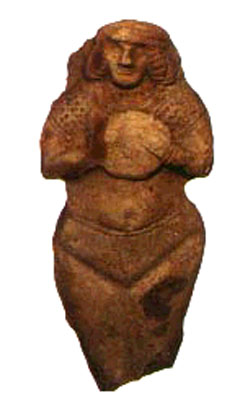 The original bread of life. Hebrew and Canaanite women molded loaves of this figure which were blessed and ritually eaten, the precursor of the communion wafer (sun god image). Her idols were found under every green tree, were carved from living trees, or erected as poles or pillars beside roadside altars. Crude clay images (or cakes) of her as tree of life later evolved into the more refined Syrian Artemis. Ancient sexual rites (dismissed to this day by male scholars as cult prostitution) associated with worship of Asherah insured that matrilineal descent patterns, with their partnership rather than dominator values, would continue. Hebrew priestly iconoclasts finally uprooted Asherah, supplanting matrifocal culture with patriarchy.
The original bread of life. Hebrew and Canaanite women molded loaves of this figure which were blessed and ritually eaten, the precursor of the communion wafer (sun god image). Her idols were found under every green tree, were carved from living trees, or erected as poles or pillars beside roadside altars. Crude clay images (or cakes) of her as tree of life later evolved into the more refined Syrian Artemis. Ancient sexual rites (dismissed to this day by male scholars as cult prostitution) associated with worship of Asherah insured that matrilineal descent patterns, with their partnership rather than dominator values, would continue. Hebrew priestly iconoclasts finally uprooted Asherah, supplanting matrifocal culture with patriarchy.When the queen of heaven (Zoe, Mary, Astarte) are worshiped it is always led by paganized women.
And the motive is always the same: we are losing our fertility. Our kids won't cut out paper dolls anymore, our attendance is shrinking, we cannot pay off the mortgage:
But since we left off to burn incense to the queen of heaven, and to pour out drink offerings unto her, we have wanted all things, and have been consumed by the sword and by the famine. Jer 44:18
And when we burned incense to the queen of heaven, and poured out drink offerings unto her, did we make her cakes to worship her, and pour out drink offerings unto her, without our men? Je.44:19
The cakes were pillars made in the image of Astarte:
Kuwn (h3559) koon; a prim. root; prop. to be erect (i. e. stand perpendicular); hence (causat.) to set up, in a great variety of applications, whether lit. (establish, fix, prepare, apply), or fig. (appoint, render sure, proper or prosperous): - certain (-ty), confirm, direct, faithfulness, fashion, fasten, firm, be fitted, be fixed, frame, be meet, ordain, order, perfect, (make) preparation, prepare (self), provide, make provision, (be, make) ready, right, set (aright, fast, forth), be stable, (e-) stablish, stand, tarry, * very deed.
I hate, I despise your feast days, and I will not smell in your solemn assemblies. Amos 5:21
Though ye offer me burnt offerings and your meat offerings, I will not accept them: neither will I regard the peace offerings of your fat beasts. Amos 5:22
........... Take thou away from me the noise of thy songs; for I will not hear the melody of thy viols. Amos 5:23But let judgment run down as waters, and righteousness as a mighty stream. Amos 5:24
Have ye offered unto me sacrifices and offerings in the wilderness forty years, O house of Israel? Amos 5:25But ye have borne the tabernacle of your Moloch and Chiun your images, the star of your god, which ye made to yourselves. Amos 5:26
Kiyyuwn (h3594) kee-yoon'; from 3559; prop. a statue, i. e. idol; but used (by euphemism) for some heathen deity (perh. corresp. to Priapus or Baal-peor): - Chiun
The hot cross buns are not now offered, but eaten, on the festival of Astarte; but this leaves no doubt as to whence they have been derived. The origin of the Pasch eggs is just as clear. The ancient Druids bore an egg, as the sacred emblem of their order. In the Dionysiaca, or mysteries of Bacchus, as celebrated in Athens, one part of the nocturnal ceremony consisted in the consecration of an egg. The Hindoo fables celebrate their mundane egg as of a golden colour. The people of Japan make their sacred egg to have been brazen. In China, at this hour, dyed or painted eggs are used on sacred festivals, even as in this country. In ancient times eggs were used in the religious rites of the Egyptians and the Greeks, and were hung up for mystic purposes in their temples.
"An egg of wondrous size is said to have fallen from heaven into the river Euphrates. The fishes rolled it to the bank, where the doves having settled upon it, and hatched it, out came Venus (Lucifer), who afterwards was called the Syrian Goddess"--that is, Astarte.
|
From Hislop also: In Berosus, the deluge is represented as coming after the time of Alorus, or the "god of fire," that is, Nimrod, which shows that there, too, this deluge was symbolical. Now, out of this deluge emerged Dagon, the fish-god, or god of the sea. 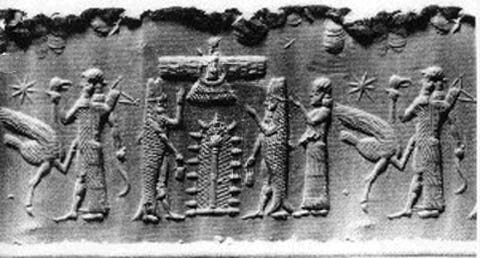
According to Babylonian legends, this aquatic deity would come on land during the day to teach the people, and would dive back at night into the Persian Gulf, where he lived in an underwater palace called the Apsu. Was Oannes the original Nommo? Or Dogon. |
Hence the egg became one of the symbols of Astarte or Easter; and accordingly, in Cyprus, one of the chosen seats of the worship of Venus, or Astarte, the egg of wondrous size was represented on a grand scale.Now the world has two distinct meanings--it means either the material earth, or the inhabitants of the earth. The latter meaning of the term is seen in Genesis 11:1, "The whole earth was of one language and of one speech," where the meaning is that the whole people of the world were so. If then the world is seen shut up in an egg, and floating on the waters, it may not be difficult to believe, however the idea of the egg may have come,
that the egg thus floating on the wide universal sea might be Noah's family that contained the whole world in its bosom.
Then the application of the word egg to the ark comes thus: The Hebrew name for an egg is Baitz, or in the feminine (for there are both genders), Baitza. This, in Chaldee and Phoenician, becomes Baith or Baitha, which in these languages is also the usual way in which the name of a house is pronounced. *
Beycah (h1000) bay-tsaw'; from the same as 948; an egg (from its whiteness): - egg.
And my hand hath found as a nest the riches of the people: and as one gathereth eggs that are left, have I gathered all the earth; and there was none that moved the wing, or opened the mouth, or peeped. Isa 10:14
Biyrah (h1002) bee-raw'; of for. or.; a castle or palace: - palace.
Bayith (h1004) bah'-yith; prob. from 1129 abbrev.; a house (in the greatest var. of applications, espec. family, etc.): - court, daughter, door, / dungeon, family, / forth of, * great as would contain, hangings, home[born], [winter]house (-hold), inside (-ward), palace, place, / prison, / steward, / tablet, temple, web, / within (-out).
* The common word "Beth," "house," in the Bible without the points, is "Baith," as may be seen in the name of Bethel, as given in Genesis 35:1, of the Greek Septuagint, where it is "Baith-el."
HEAR this word, ye kine of Bashan, that are in the mountain of Samaria, which oppress the poor, which crush the needy, which say to their masters, Bring, and let us drink. Amos 4:1
The Lord God hath sworn by his holiness, that, lo, the days shall come upon you, that he will take you away with hooks, and your posterity with fishhooks. Amos 4:2
And ye shall go out at the breaches, every cow at that which is before her; and ye shall cast them into the palace, saith the Lord. Amos 4:3
Come to Beth-el, and transgress; at Gilgal multiply transgression; and bring your sacrifices every morning, and your tithes after three years: Amos 4:4
And offer a sacrifice of thanksgiving with leaven, and proclaim and publish the free offerings: for this liketh you, O ye children of Israel, saith the Lord God. Amos 4:5
For thus saith the Lord unto the house of Israel, Seek ye me, and ye shall live: Amos 5:4
But seek not Beth-el, nor enter into Gilgal, and pass not to Beer-sheba: for Gilgal shall surely go into captivity, and Beth-el shall come to nought. Amos 5:5
Take thou away from me the noise of thy songs; for I will not hear the melody of thy viols. Amos 5:23
The egg floating on the waters that contained the world, was the house floating on the waters of the deluge, with the elements of the new world in its bosom. The coming of the egg from heaven evidently refers to the preparation of the ark by express appointment of God; and the same thing seems clearly implied in the Egyptian story of the mundane egg which was said to have come out of the mouth of the great god.
The doves resting on the egg need no explanation. This, then, was the meaning of the mystic egg in one aspect. As, however, everything that was good or beneficial to mankind was represented in the Chaldean mysteries, as in some way connected with the Babylonian goddess, so the greatest blessing to the human race, which the ark contained in its bosom, was held to be Astarte, who was the great civiliser and benefactor of the world.
Though the deified queen, whom Astarte represented, had no actual existence till some centuries after the flood, yet through the doctrine of metempsychosis, which was firmly established in Babylon, it was easy for her worshippers to be made to believe that, in a previous incarnation, she had lived in the Antediluvian world, and passed in safety through the waters of the flood.
Now the Romish Church adopted this mystic egg of Astarte, and consecrated it as a symbol of Christ's resurrection. A form of prayer was even appointed to be used in connection with it,
Pope Paul V teaching his superstitious votaries thus to pray at Easter: "Bless, O Lord, we beseech thee, this thy creature of eggs,
........... that it may become a wholesome sustenance unto thy servants,
........... eating it in remembrance of our Lord Jesus Christ, &c;" (Scottish Guardian, April, 1844).Besides the mystic egg, there was also another emblem of Easter, the goddess queen of Babylon, and that was the Rimmon or "pomegranate." (see illustration below) With the Rimmon or "pomegranate" in her hand, she is frequently represented in ancient medals, and the house of Rimmon, in which the King of Damascus, the Master of Naaman, the Syrian, worshipped, was in all likelihood a temple of Astarte, where that goddess with the Rimmon was publicly adored.
The pomegranate is a fruit that is full of seeds; and on that account it has been supposed that it was employed as an emblem of that vessel in which the germs of the new creation were preserved, wherewith the world was to be sown anew with man and with beast, when the desolation of the deluge had passed away. But upon more searching inquiry, it turns out that the Rimmon or "pomegranate" had reference to an entirely different thing. Astarte, or Cybele, was called also Idaia Mater, and the sacred mount in Phrygia, most famed for the celebration of her mysteries, was named Mount Ida--that is, in Chaldee, the sacred language of these mysteries, the Mount of Knowledge. "Idaia Mater," then, signifies "the Mother of Knowledge"--in other words, our Mother Eve, who first coveted the "knowledge of good and evil," and actually purchased it at so dire a price to herself and to all her children.
ZOE in its modern form is Mary, the mother of god. Therefore, the acceptance of the young Catholic Trinity accepts Father, Mother (Sophia-Zoe) and baby son.
See the Gifts which Inanna (Ishtar) stole from Ea (the patron god of music) after getting him drunk.
Astarte, as can be abundantly shown, was worshipped not only as an incarnation of the Spirit of God, but also of the mother of mankind. (see note below) When, therefore, the mother of the gods, and the mother of knowledge, was represented with the fruit of the pomegranate in her extended hand,
"Tree, whose mortal taste.
Brought death into the world, and all our woe."See the Partridge In a Pear Tree Paganism See the Mother of the Gods and Clanging Music The knowledge to which the votaries of the Idaean goddess were admitted, was precisely of the same kind as that which Eve derived from the eating of the forbidden fruit, the practical knowledge of all that was morally evil and base.Yet to Astarte, in this character,
men were taught to look at their grand benefactress,
as gaining for them knowledge, and blessings connected with that knowledge,
which otherwise they might in vain have sought from Him, who is the Father of lights, from whom cometh down every good and perfect gift.Popery inspires the same feeling in regard to the Romish queen of heaven, and leads its devotees to view the sin of Eve in much the same light as that in which Paganism regarded it.
In the Canon of the Mass, the most solemn service in the Romish Missal, the following expression occurs, where the sin of our first parent is apostrophised:
"Oh blessed fault, which didst procure such a Redeemer!"
The idea contained in these words is purely Pagan.
They just amount to this: "Thanks be to Eve, to whose sin we are indebted for the glorious Saviour."
It is true the idea contained in them is found in the same words in the writings of Augustine; but it is an idea utterly opposed to the spirit of the Gospel,which only makes sin the more exceeding sinful, from the consideration that it needed such a ransom to deliver from its awful curse. Augustine had imbibed many Pagan sentiments, and never got entirely delivered from them.
As Rome cherishes the same feelings as Paganism did, so it has adopted also the very same symbols, so far as it has the opportunity. In this country, and most of the countries of Europe, no pomegranates grow; and yet, even here, the superstition of the Rimmon must, as far as possible, be kept up.
Instead of the pomegranate, therefore, the orange is employed;
and so the Papists of Scotland join oranges with their eggs at Easter; and so also, when Bishop Gillis of Edinburgh went through the vain-glorious ceremony of washing the feet of twelve ragged Irishmen a few years ago at Easter, he concluded by presenting each of them with two eggs and an orange.
Now, this use of the orange as the representative of the fruit of Eden's "dread probationary tree," be it observed, is no modern invention; it goes back to the distant times of classic antiquity. The gardens of the Hesperides in the West, are admitted by all who have studied the subject, just to have been the counterpart of the paradise of Eden in the East.
The description of the sacred gardens, as situated in the Isles of the Atlantic, over against the coast of Africa, shows that their legendary site exactly agrees with the Cape Verd or Canary Isles, or some of that group; and, of course, that the "golden fruit" on the sacred tree, so jealously guarded, was none other than the orange. Now, let the reader mark well:
According to the classic Pagan story, there was no serpent in that garden of delight in the "islands of the blest," to TEMPT mankind to violate their duty to their great benefactor, by eating of the sacred tree which he had reserved as the test of their allegiance.
No; on the contrary, it was the Serpent, the symbol of the Devil, the Principle of evil, the Enemy of man, that prohibited them from eating the precious fruit--that strictly watched it--that would not allow it to be touched.
Hercules, one form of the Pagan Messiah--not the primitive, but the Grecian Hercules--pitying man's unhappy state, slew or subdued the serpent, the envious being that grudged mankind the use of that which was so necessary to make them at once perfectly happy and wise, and bestowed upon them what otherwise would have been hopelessly beyond their reach. Here, then, God and the devil are exactly made to change places.
Jehovah, who prohibited man from eating of the tree of knowledge, is symbolised by the serpent, and held up as an ungenerous and malignant being, while he who emancipated man from Jehovah's yoke, and gave him of the fruit of the forbidden tree--in other words, Satan under the name of Hercules--is celebrated as the good and gracious Deliverer of the human race. What a mystery of iniquity is here! Now all this is wrapped up in the sacred orange of Easter.
"To revive gods and goddesses is no small task. Above all, it is not a task that reason or personal motives can accomplish or even assist in. One cannot construct archetypes on the basis of recognitions reached by the personal complex of mind and emotions. David L. Miller rightly observes:
"The Gods and Goddesses are not cute allegories and analogies, figures of speech for evangelizing and moralistic orators, just as they are neither psychological nor social roles. Rather, they are worlds of our existence; the deepest structures of reality. If we conjure up the presence of such structures of reality primarily or even partly because we would like to advance our own purposes, we commit sacrilege and invite the cruel retribution of the Olympians. Our watchword in these matters must never be "I want," but rather "do as Thou wilt." Ideologies, politics, "isms" of all kinds, as well as personal hurt and anger, must be left behind in the outer court. They must not be smuggled into the sanctuary where the deities reside. Of course, much of the contemporary "paganizing" and "Goddess talk" will not pass muster by these stringent yet essential standards.
"The discovery and assimilation of early heterodox Christian scriptures (such as the Nag Hammadi library) will also facilitate the revival of goddess figures within a new Gnostic Christian mythos. Goddesses such as Barbelo and Sophia, demigoddesses like Eve-Zoe and Norea, and heroines such as Mary Magdalene are emerging from exile and are awaiting reincorporation into Christian scriptures and liturgy. Things have never looked so good for a recovery of our polytheistic heritage and of our beautiful and mighty goddesses of old. One even feels that Christ, the incarnate paradigm of the Fullness, who assured us that in his Father's house there are many divinities [John 10:43.] would be pleased by the coming of a new polytheism.
See the most ancient records of Sophia (Serpent) and Zoe (beast) had to teach little "jehovah" and therefore ZOE is "the female instructing principle." Since paganized or feminists women have taken control of the early teaching program we have both an effeminate and a paganized church.
Note
The Meaning of the Name Astarte That Semiramis, under the name of Astarte, was worshipped not only as an incarnation of the Spirit of God, but as the mother of mankind, we have very clear and satisfactory evidence. There is no doubt that "the Syrian goddess" was Astarte (LAYARD'S Nineveh and its Remains).Now, the Assyrian goddess, or Astarte, is identified with Semiramis by Athenagoras (Legatio), and by Lucian (De Dea Syria). These testimonies in regard to Astarte, or the Syrian goddess, being, in one aspect, Semiramis, are quite decisive.
The Easter Tree or Astarte Tree is in the background. As a type of palm it was produced fertility just like the easter bunny lays eggs which must now be attacked to the tree of knowledge to have LIFE (Zoe).
Hathor as Qadesh (prostitute) the Syrian fertility goddess with phallic Min. Note the Hathor crown and headdress. She stands on a lion, holding a serpent and ears of grain (Graves 1946, Pritchard 1954) It is a fact that she can increase your attendance and entertain the kids. On the contrary: And I wept much, because no man was found worthy to open and to read the book, neither to look thereon. Revelation 5:4And one of the elders saith unto me, Weep not: behold, the Lion of the tribe of Juda, the Root of David, hath prevailed to open the book, and to loose the seven seals thereof. Revelation 5:5
Johannes Quasten. In Music and Worship in Pagan and Christian Antiquity, beginning on page 41 He uses many of the church Fathers and Classical resources notes the dead give away to paganized worship:"Philodemus considered it paradoxical that music should be regarded as veneration of the gods while musicians were paid for performing this so-called veneration. Again, Philodemus held as self deceptive the view that music mediated religious ecstasy. He saw the entire condition induced by the noise of cymbals and tambourines as a disturbance of the spirit.
He found it significant that, on the whole, only women and effeminate men fell into this folly.
Accordingly, nothing of value could be attributed to music; it was no more than a slave of the sensation of pleasure, which satisfied much in the same way that food and drink did.
Women's singing was a vital part of all pagan worship. In very early times women became priestly singers of the gods in the temple.
"Women and girls from the different ranks of society were proud to enter the service of the gods as singers and musicians. The understanding of this service was universal: these singers constituted the 'harem of the gods'."
McClintock and Strong note that even male clergy musicians was "the first heresy largely pervading the church."
Inanna or Astarte got Ea, the patron god of music, drunk and stole he ME. This gave her power over the "eldership, sexual perversion and musical performance." Perhaps males are drunk from new wineskins or "drunk on ignorance."
And in the feminine, as given in Hesychius (Lexicon), we find the meaning much more decisively brought out. Turis is just the Greek form of Turit, the final t, according to the genius of the Greek language, being converted into s. Ash-turit, then, which is obviously the same as the Hebrew "Ashtoreth," is just "The woman that made the encompassing wall." Considering how commonly the glory of that achievement, as regards Babylon, was given to Semiramis, not only by Ovid, but by Justin, Dionysius, Afer, and others, both the name and mural crown on the head of that goddess were surely very appropriate. In confirmation of this interpretation of the meaning of the name Astarte, I may adduce an epithet applied to the Greek Diana, who at Ephesus bore a turreted crown on her head, and was identified with Semiramis, which is not a little striking. It is contained in the following extract from Livy: "When the news of the battle [near Pydna] reached Amphipolis, the matrons ran together to the temple of Diana, whom they style Tauropolos, to implore her aid." Tauropolos, from Tor, "a tower," or "surrounding fortification," and Pol, "to make," plainly means the "tower-maker," or "maker of surrounding fortifications"; and P53 to her as the goddess of fortifications, they would naturally apply when they dreaded an attack upon their city.
The panel shows a woman with Egyptian-style hair looking out of what appears to be a window. It is often thought that she is a sacred prostitute, connected with Astarte or Ishtar, goddess of fertility, but the exact significance of the scene is unclear. Versions of these panels can be seen decorating the legs of a couch on which King Ashurbanipal reclines in the 'Garden Party' scene at Nineveh.
Ivory was clearly popular as a form of decoration throughout the Near East. Examples of various styles but of similar date are also known from elsewhere at Nimrud, where they may have been part of captured booty or tribute, as well as from the Assyrian city of Khorsabad, and further afield in Syria and Israel.
Semiramis, being deified as Astarte, came to be raised to the highest honours; and her change into a dove, as has been already shown, was evidently intended, when the distinction of sex had been blasphemously attributed to the Godhead, to identify her, under the name of the Mother of the gods, with that Divine Spirit, without whose agency no one can be born a child of God, and whose emblem, in the symbolical language of Scripture, was the Dove, as that of the Messiah was the Lamb.
Since the Spirit of God is the source of all wisdom, natural as well as spiritual, arts and inventions and skill of every kind being attributed to Him (Exo 31:3; 35:31), so the Mother of the gods, in whom that Spirit was feigned to be incarnate, was celebrated as the originator of some of the useful arts and sciences (DIODORUS SICULUS). Hence, also, the character attributed to the Grecian Minerva, whose name Athena, as we have seen reason to conclude, is only a synonym for Beltis, the well known name of the Assyrian goddess. Athena, the Minerva of Athens, is universally known as the "goddess of wisdom," the inventress of arts and sciences.
2. The name Astarte signifies also the "Maker of investigations"; and in this respect was applicable to Cybele or Semiramis, as symbolised by the Dove. That this is one of the meanings of the name Astarte may be seen from comparing it with the cognate names Asterie and Astraea (in Greek Astraia), which are formed by taking the last member of the compound word in the masculine, instead of the feminine, Teri, or Tri (the latter being pronounced Trai or Trae), being the same in sense as Tart.
See Heredotus on the dove as spirit.
Now, Asterie was the wife of Perseus, the Assyrian (HERODOTUS), and who was the founder of Mysteries (BRYANT). As Asterie was further represented as the daughter of Bel, this implies a position similar to that of Semiramis.
Astraea, again, was the goddess of justice, who is identified with the heavenly virgin Themis, the name Themis signifying "the perfect one," who gave oracles (OVID, Metam.), and who, having lived on earth before the Flood, forsook it just before that catastrophe came on.
Themis and Astraea are sometimes distinguished and sometimes identified; but both have the same character as goddesses of justice. The explanation of the discrepancy obviously is, that the Spirit has sometimes been viewed as incarnate and sometimes not. When incarnate, Astraea is daughter of Themis. What name could more exactly agree with the character of a goddess of justice,
than Ash-trai-a, "The maker of investigations," and what name could more appropriately shadow forth one of the characters of that Divine Spirit, who "searcheth all things, yea, the deep things of God"?
As Astraea, or Themis, was "Fatidica Themis," "Themis the prophetic," this also was another characteristic of the Spirit; for whence can any true oracle, or prophetic inspiration, come, but from the inspiring Spirit of God? Then, lastly, what can more exactly agree with the Divine statement in Genesis in regard to the Spirit of God, than the statement of Ovid, that Astraea was the last of the celestials who remained on earth, and that her forsaking it was the signal for the downpouring of the destroying deluge?
The announcement of the coming Flood is in Scripture ushered in with these words (Gen 6:3): "And the Lord said, My Spirit shall not always strive with man, for that he also is flesh: yet his days shall be an hundred and twenty years." All these 120 years, the Spirit was striving; when they came to an end, the Spirit strove no longer, forsook the earth, and left the world to its fate. But though the Spirit of God forsook the earth, it did not forsake the family of righteous Noah. It entered with the patriarch into the ark; and when that patriarch came forth from his long imprisonment, it came forth along with him.
Thus the Pagans had an historical foundation for their myth of the dove resting on the symbol of the ark in the Babylonian waters, and the Syrian goddess, or Astarte--the same as Astraea--coming forth from it.
Semiramis, then, as Astarte, worshipped as the dove, was regarded as the incarnation of the Spirit of God.
3. As Baal, Lord of Heaven, had his visible emblem, the sun, so she, as Beltis, Queen of Heaven, must have hers also--the moon, which in another sense was Asht-tart-e, "The maker of revolutions"; for there is no doubt that Tart very commonly signifies "going round." But,
4th, the whole system must be dovetailed together. As the mother of the gods was equally the mother of mankind, Semiramis, or Astarte, must also be identified with Eve; and the name Rhea, which, according to the Paschal Chronicle was given to her, sufficiently proves her identification with Eve.
As applied to the common mother of the human race, the name Astarte is singularly appropriate; for, as she was Idaia mater, "The mother of knowledge," the question is, "How did she come by that knowledge?" To this the answer can only be: "by the fatal investigations she made."
It was a tremendous experiment she made, when, in opposition to the Divine command, and in spite of the threatened penalty,
she ventured to "search" into that forbidden knowledge which her Maker in his goodness had kept from her.
Thus she took the lead in that unhappy course of which the Scripture speaks--"God made man upright, but they have SOUGHT out many inventions" (Eccl 7:29).Now Semiramis, deified as the Dove, was Astarte in the most gracious and benignant form. Lucius Ampelius calls her "the goddess benignant and merciful to me" (bringing them) "to a good and happy life." In reference to this benignity of her character, both the titles, Aphrodite and Mylitta, are evidently attributed to her. The first I have elsewhere explained as "The wrath-subduer," and the second is in exact accordance with it. Mylitta, or, as it is in Greek, Mulitta, signifies "The Mediatrix." The Hebrew Melitz, which in Chaldee becomes Melitt, is evidently used in Job 33:23, in the sense of a Mediator; "the messenger, the interpreter" (Melitz), who is "gracious" to a man, and saith, "Deliver from going down to the pit: I have found a ransom," being really "The Messenger, the MEDIATOR." Parkhurst takes the word in this sense, and derives it from "Mltz," "to be sweet."
Now, the feminine of Melitz is Melitza, from which comes Melissa, a "bee" (the sweetener, or producer of sweetness), and Melissa, a common name of the priestesses of Cybele, and as we may infer of
Cybele, as Astarte, or Queen of Heaven, herself; for, after Porphyry, has stated that "the ancients called the priestesses of Demeter, Melissae," he adds, that they also "called the Moon Melissa." We have evidence, further, that goes far to identify this title as a title of Semiramis. Melissa or Melitta (APPOLODORUS)--for the name is given in both ways--is said to have been the mother of Phoroneus, the first that reigned, in whose days the dispersion of mankind occurred, divisions having come in among them, whereas before, all had been in harmony and spoke one language (Hyginus).
There is no other to whom this can be applied but Nimrod; and as Nimrod came to be worshipped as Nin, the son of his own wife, the identification is exact.
Melitta, then, the mother of Phoroneus, is the same as Mylitta, the well known name of the Babylonian Venus; and the name, as being the feminine of Melitz, the Mediator, consequently signifies the Mediatrix. Another name also given to the mother of Phoroneus, "the first that reigned," is Archia (LEMPRIERE; SMITH). Now Archia signifies "Spiritual" (from "Rkh," Heb. "Spirit," which in Egyptian also is "Rkh" [BUNSEN]; and in Chaldee, with the prosthetic a prefixed becomes Arkh). * From the same root also evidently comes the epithet Architis, as applied to the Venus that wept for Adonis. Venus Architis is the spiritual Venus. **
* The Hebrew Dem, blood, in Chaldee becomes Adem; and, in like manner, Rkh becomes Arkh.
** From OUVAROFF we learn that the mother of the third Bacchus was Aura, and Phaethon is said by Orpheus to have been the son of the "wide extended air" (LACTANTIUS). The connection in the sacred language between the wind, the air, and the spirit, sufficiently accounts for these statements, and shows their real meaning.
Thus, then, the mother-wife of the first king that reigned was known as Archia and Melitta, in other words, as the woman in whom the "Spirit of God" was incarnate; and thus appeared as the "Dea Benigna," "The Mediatrix" for sinful mortals. The first form of Astarte, as Eve, brought sin into the world; the second form before the Flood, was avenging as the goddess of justice. This form was "Benignant and Merciful." Thus, also, Semiramis, or Astarte, as Venus the goddess of love and beauty, became "The HOPE of the whole world," and men gladly had recourse to the "mediation" of one so tolerant of sin.
Some Notes on The Book of The Bee
See more Zoe-Mediatrix-Beast connection
<img src="cgi-bin/Count.cgi?df=piney/counter_His32.html.dat">

